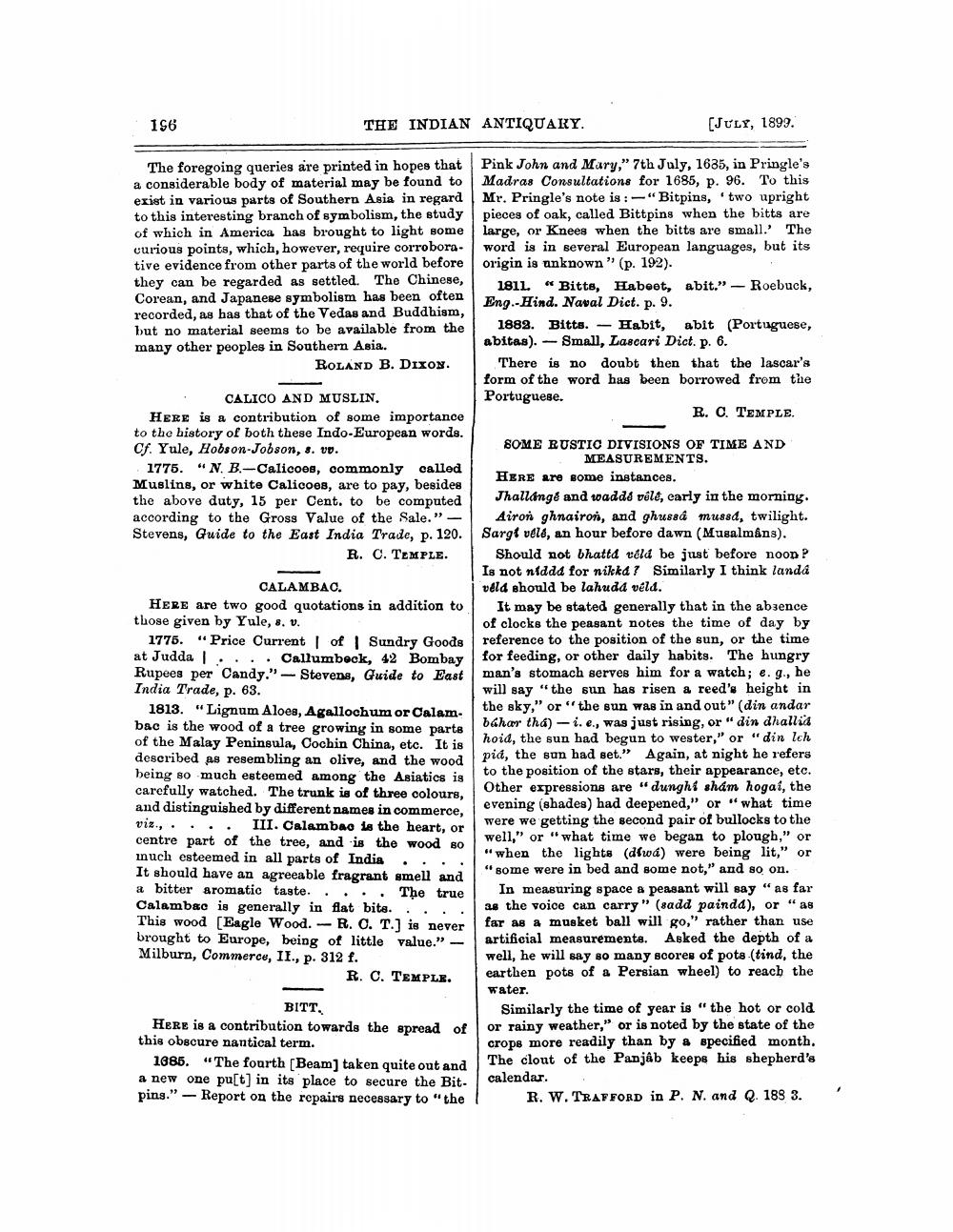________________
196
The foregoing queries are printed in hopes that a considerable body of material may be found to exist in various parts of Southern Asia in regard to this interesting branch of symbolism, the study of which in America has brought to light some curious points, which, however, require corroborative evidence from other parts of the world before they can be regarded as settled. The Chinese, Corean, and Japanese symbolism has been often recorded, as has that of the Vedas and Buddhism, but no material seems to be available from the many other peoples in Southern Asia.
ROLAND B. DIXON.
THE INDIAN ANTIQUARY.
CALICO AND MUSLIN.
HERE is a contribution of some importance to the history of both these Indo-European words. Cf. Yule, Hobson-Jobson, s. vv.
1775. "N. B.-Calicoes, commonly called Muslins, or white Calicoes, are to pay, besides the above duty, 15 per Cent. to be computed according to the Gross Value of the Sale."Stevens, Guide to the East India Trade, p. 120. R. C. TEMPLE.
CALAMBAC.
HERE are two good quotations in addition to those given by Yule, s. v.
1775. "Price Current of Sundry Goods at Judda ... Callumbeck, 42 Bombay Rupees per Candy." Stevens, Guide to East India Trade, p. 63.
1813. "Lignum Aloes, Agallochum or Calambac is the wood of a tree growing in some parts of the Malay Peninsula, Cochin China, etc. It is described as resembling an olive, and the wood being so much esteemed among the Asiatics is carefully watched. The trunk is of three colours, and distinguished by different names in commerce, viz.,. III. Calambac is the heart, or centre part of the tree, and is the wood so much esteemed in all parts of India
It should have an agreeable fragrant smell and a bitter aromatic taste. The true Calambac is generally in flat bits. This wood [Eagle Wood. R. C. T.] is never brought to Europe, being of little value.". Milburn, Commerce, II., p. 312 f.
R. C. TEMPLE.
BITT,
HERE is a contribution towards the spread of this obscure nantical term.
-
1885. "The fourth [Beam] taken quite out and a new one pu[t] in its place to secure the Bit
pins." Report on the repairs necessary to "the
[JULY, 1899.
"
Pink John and Mary," 7th July, 1685, in Pringle's Madras Consultations for 1685, p. 96. To this Mr. Pringle's note is: "Bitpins, two upright pieces of oak, called Bittpins when the bitts are large, or Knees when the bitts are small.' The word is in several European languages, but its origin is unknown" (p. 192).
1811. "Bitts, Habeet, abit." - Roebuck,
Eng.-Hind. Naval Dict. p. 9.
1882. Bitts. - Habit, abit (Portuguese, abitas). Small, Lascari Dict. p. 6.
-
There is no doubt then that the lascar's form of the word has been borrowed from the Portuguese.
R. C. TEMPLE.
SOME RUSTIC DIVISIONS OF TIME AND MEASUREMENTS.
HERE are some instances.
Jhallange and waddé vélé, early in the morning. Airon ghnairon, and ghussá mussd, twilight. Sargt vélé, an hour before dawn (Musalmans).
Should not bhattá véld be just before noon? Is not niddd for nikkd? Similarly I think landa veld should be lahudá véla.
It may be stated generally that in the absence of clocks the peasant notes the time of day by reference to the position of the sun, or the time for feeding, or other daily habits. The hungry man's stomach serves him for a watch; e. g., he will say "the sun has risen a reed's height in the sky," or "the sun was in and out" (din andar bahar tha) i. e., was just rising, or " din dhallia hoid, the sun had begun to wester," or "din leh pid, the sun had set." Again, at night he refers to the position of the stars, their appearance, etc. Other expressions are "dunghi shám hogai, the evening (shades) had deepened," or "what time were we getting the second pair of bullocks to the well," or "what time we began to plough," or "when the lights (díwá) were being lit," or 'some were in bed and some not," and so on.
44
In measuring space a peasant will say as far as the voice can carry" (sadd painda), or "as far as a musket ball will go," rather than use artificial measurements. Asked the depth of a well, he will say so many scores of pots (tind, the earthen pots of a Persian wheel) to reach the water.
Similarly the time of year is "the hot or cold or rainy weather," or is noted by the state of the crops more readily than by a specified month. The clout of the Panjab keeps his shepherd's calendar.
R. W. TRAFFORD in P. N. and Q. 188 3.




